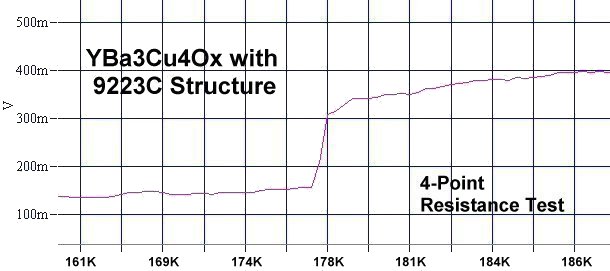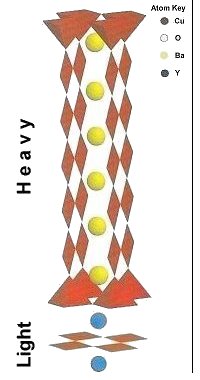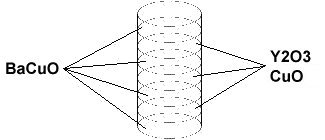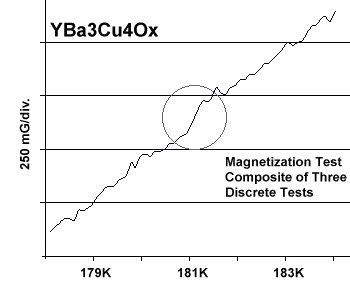


|
Standard 91K YBCO (Y-123) has only 6 metal layers in the unit cell and very little PWD.
In this new discovery - based on a 9223C theoretical structure type shown at left - there are 16 metal layers and a large
amount of PWD.
The closest analog to this structure type is the B212/1212C intergrowth of the Sn-Ba-Ca-Cu-O family,
with Tc near 200K.
The chemical formula of this new discovery - dubbed "Hyper YBCO" - is Y2Ba6Cu8Ox. However, HY-268 does not form stoichiometrically. In order to synthesize a sufficent volume fraction to detect, the "layer cake" method must be used. The layer cake used to produce the prototype pellet had 17 layers, 9 of (BaCuO) and 8 of (Y2O3 + CuO). This resulted in 16 interference regions in which the desired structure was encouraged to form. The layer cake method is depicted in the simplified graphic below.  |
Below is a composite plot
of three magnetization tests that were digitally summed to improve the signal-to-noise ratio.
Weak diamagnetic transitions also appeared near 165K and 185K. These are believed
to have resulted from minority phases: one less Ba-Cu layer for the 165K signal (7223C structure)
and one more Ba-Cu layer for the 185K signal (B223C structure).
These are the highest transition temperatures ever observed in a quaternary (four element) compound.

Synthesis of HY-268 was by the solid state reaction method. Stoichiometric amounts of the below precursors were mixed, layered, pelletized at 70,000 psi and then sintered for 11 hours at 890C. The pellet was then annealed for 10 hours at 500C in flowing O2.
Y2O3 99.99% (Alfa Aesar) 2.15 grainsThe magnetometer employed twin Honeywell SS94A1F Hall-effect sensors with a tandem sensitivity of 50 mv/gauss. The 4-point probe was bonded to the pellet with CW2400 silver epoxy and used 7 volts on the primary.
RESEARCH NOTE: The copper-oxides are strongly hygroscopic. All tests should be performed immediately after annealing.
E. Joe Eck
© 2009 Superconductors.ORG
All rights reserved.
 BACK to "News" page at Superconductors.ORG
BACK to "News" page at Superconductors.ORG